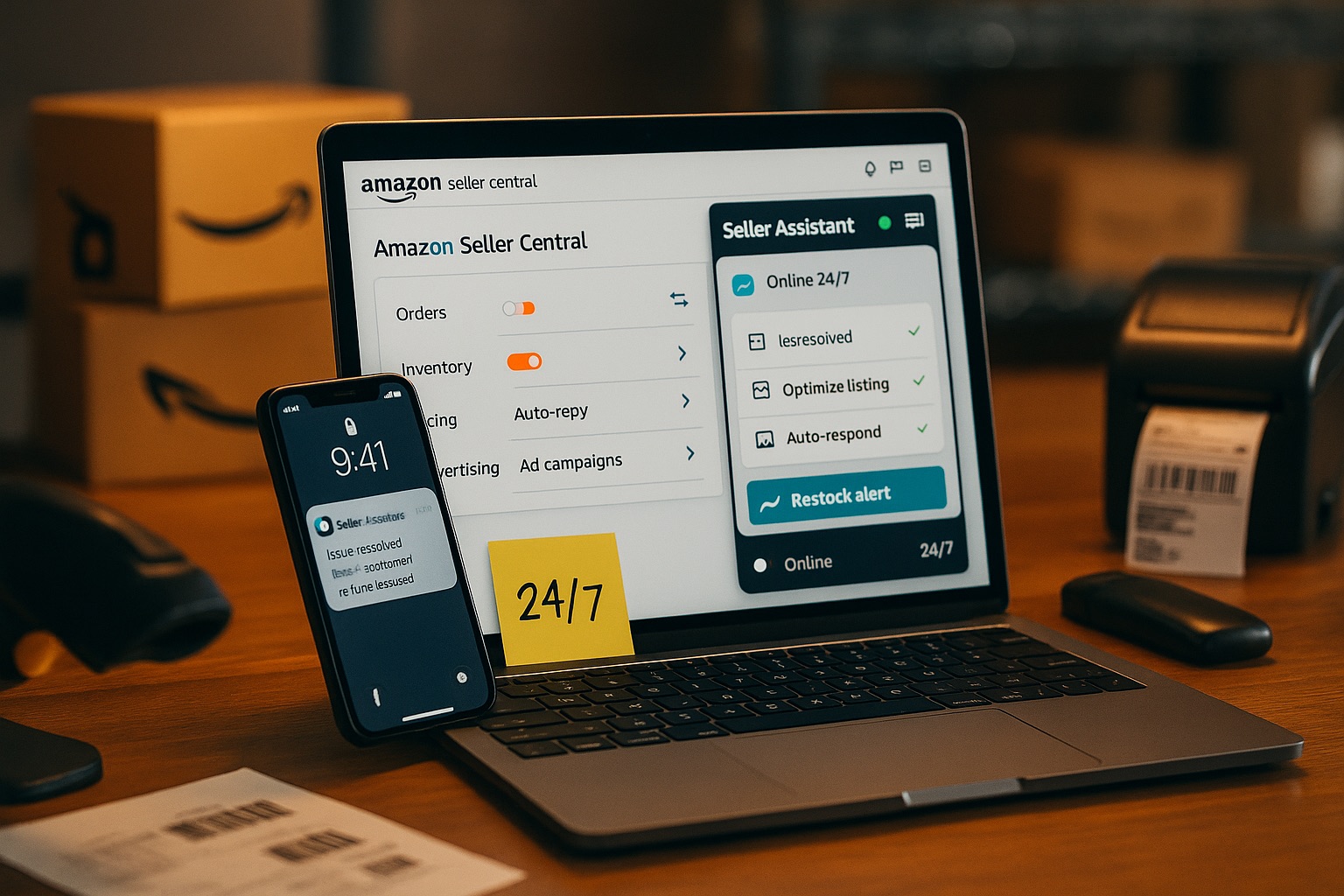Amazon dropped something that could fundamentally change how millions of third-party sellers run their businesses. Their updated Seller Assistant isn’t just another AI chatbot—it’s an always-on AI agent that actually takes action on your behalf, handles routine operations, and even develops business strategies while you sleep. Think of it like having a brilliant business partner who never takes breaks and actually enjoys analyzing inventory data.
This represents a massive shift from reactive AI tools to proactive AI agents that work around the clock. Instead of sellers constantly managing every detail of their Amazon business, they now have an intelligent assistant that monitors, analyzes, and acts on their behalf. The implications extend far beyond simple automation—this is about fundamentally changing the seller experience on the world’s largest e-commerce platform.
For the millions of third-party sellers who generate over 60% of Amazon’s retail revenue, this could be the difference between scaling successfully and drowning in operational complexity.
From Simple Assistant to Strategic Business Partner
Traditional AI tools wait for you to ask questions. Amazon’s upgraded Seller Assistant works more like a proactive business consultant who constantly monitors your account and jumps into action when opportunities or problems arise.
What makes this agentic AI different:
- Continuous account monitoring without manual prompts
- Proactive identification of issues before they become expensive problems
- Strategic recommendations based on comprehensive business analysis
- Authorized action-taking capabilities rather than just suggestions
- Integration across the entire selling experience from inventory to advertising
The “always-on” aspect feels genuinely revolutionary for busy sellers. Instead of logging in daily to check inventory levels, review account health, and analyze performance metrics, sellers can focus on product development and growth strategies while their AI agent handles operational oversight.
Real-world scenario: Your inventory starts moving slowly in October. Traditional tools might flag this weeks later when you manually check reports. Seller Assistant identifies the trend early, calculates potential long-term storage fees, analyzes seasonal demand patterns, and recommends specific actions—all before you even realize there’s a problem.
Smart Inventory Management That Actually Prevents Problems
Inventory management represents one of the biggest headaches for Amazon sellers. Long-term storage fees can devastate profit margins, while stockouts kill momentum and rankings. Seller Assistant transforms this from reactive firefighting to predictive strategy.
Advanced inventory capabilities include:
- Slow-moving product identification before storage fees accumulate
- Demand pattern analysis for better forecasting
- Automated compliance monitoring across multiple countries
- Shipment planning recommendations based on predictive analytics
- Price optimization suggestions tied to inventory velocity
The compliance monitoring feature alone could save sellers thousands. Product safety regulations change frequently across different markets, and violations can result in listing suspensions or account penalties. Having an AI agent continuously verify compliance requirements across every market where you sell removes a major source of seller anxiety.
Practical example: You’re selling in the US, UK, and Germany simultaneously. New toy safety regulations take effect in the EU that affect one of your products. Seller Assistant flags this immediately, analyzes your inventory levels across all markets, and recommends whether to adjust pricing, modify listings, or remove the product entirely from affected regions.
Strategic Business Analysis That Goes Beyond Basic Analytics
Most Amazon analytics tools tell you what happened. Seller Assistant analyzes patterns, predicts outcomes, and recommends strategic changes that could improve your business performance long-term.
Strategic capabilities expanding beyond routine operations:
- Business strategy development based on comprehensive data analysis
- Market opportunity identification through demand pattern recognition
- Competitive positioning recommendations
- Growth strategy optimization across product categories
- Resource allocation guidance for maximum ROI
This strategic layer distinguishes Seller Assistant from simple inventory management tools. The AI doesn’t just prevent problems—it actively identifies opportunities for business growth and optimization that human sellers might miss while focused on daily operations.
The authorization model ensures sellers maintain control while benefiting from AI efficiency. Instead of the AI making irreversible changes, it requests permission for significant actions while handling routine maintenance automatically.
Advertising Gets the AI Agent Treatment Too
Amazon simultaneously announced agentic AI for advertising, allowing sellers to develop ad campaigns through conversational prompts rather than complex campaign management interfaces. This integration suggests Amazon envisions AI agents handling comprehensive business management rather than isolated tasks.
Conversational advertising development means:
- Natural language campaign creation (“Create ads for my best-selling kitchen products targeting cooking enthusiasts”)
- Automated optimization based on performance data
- Strategic budget allocation across multiple product lines
- Cross-platform advertising coordination
- Real-time campaign adjustment based on inventory levels
The integration potential between inventory management and advertising creates powerful synergies. When Seller Assistant identifies slow-moving inventory, it can automatically suggest advertising campaigns to boost sales, coordinate with the advertising agent to implement campaigns, and monitor results—all while keeping sellers informed and in control.
Competitive Landscape: How This Positions Amazon Against Rivals
Agent-driven commerce represents the next battleground for tech companies building e-commerce platforms. Google recently released a new payments protocol for agentic transactions, though Amazon wasn’t listed as a partner, suggesting different strategic approaches to AI agent integration.
Amazon’s comprehensive approach includes:
- Platform-native AI agents that understand Amazon’s specific requirements
- Deep integration with existing seller tools and processes
- Continuous learning from millions of seller interactions
- Seamless coordination between inventory, advertising, and compliance management
- Always-on availability that matches the global nature of e-commerce
Compared to third-party seller tools, Amazon’s native AI agent offers advantages in data access, integration depth, and platform-specific optimization. Independent tools often struggle with API limitations and delayed data access that could handicap real-time decision making.
What This Means for the Future of E-commerce Management
Amazon’s AI agent evolution suggests a future where successful e-commerce requires human creativity and strategic thinking while AI handles operational complexity and routine optimization.
Implications for different seller types:
- Small sellers get access to enterprise-level business intelligence and automation
- Large sellers can scale operations without proportionally increasing management overhead
- New sellers receive guided business development that historically required years of experience
- International sellers get compliance and market analysis across multiple regions
The learning curve consideration: While AI agents reduce operational complexity, sellers still need to understand their business fundamentals to provide effective guidance and make strategic decisions. The most successful sellers will likely be those who learn to collaborate effectively with AI rather than simply delegating everything.
Amazon’s comprehensive AI agent approach positions the platform as increasingly essential for serious e-commerce sellers while raising the competitive bar for rival platforms still relying on traditional seller tools and interfaces.


Post a comment